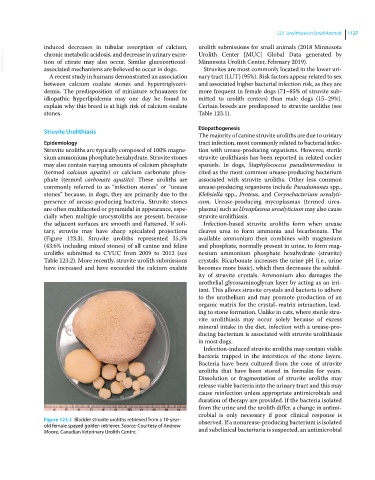Page 1189 - Clinical Small Animal Internal Medicine
P. 1189
123 Urolithiasis in Small Animals 1127
induced decreases in tubular resorption of calcium, urolith submissions for small animals (2018 Minnesota
VetBooks.ir chronic metabolic acidosis, and decrease in urinary excre Urolith Center [MUC] Global Data generated by
Minnesota Urolith Center, February 2019).
tion of citrate may also occur. Similar glucocorticoid‐
associated mechanisms are believed to occur in dogs.
Struvites are most commonly located in the lower uri
A recent study in humans demonstrated an association nary tract (LUT) (95%). Risk factors appear related to sex
between calcium oxalate stones and hypertriglyceri and associated higher bacterial infection risk, as they are
demia. The predisposition of miniature schnauzers for more frequent in female dogs (71–85% of struvite sub
idiopathic hyperlipidemia may one day be found to mitted to urolith centers) than male dogs (15–29%).
explain why this breed is at high risk of calcium oxalate Certain breeds are predisposed to struvite uroliths (see
stones. Table 123.1).
Etiopathogenesis
Struvite Urolithiasis
The majority of canine struvite uroliths are due to urinary
Epidemiology tract infection, most commonly related to bacterial infec
Struvite uroliths are typically composed of 100% magne tion with urease‐producing organisms. However, sterile
sium ammonium phosphate hexahydrate. Struvite stones struvite urolithiasis has been reported in related cocker
may also contain varying amounts of calcium phosphate spaniels. In dogs, Staphylococcus pseudintermedius is
(termed calcium apatite) or calcium carbonate phos cited as the most common urease‐producing bacterium
phate (termed carbonate apatite). These uroliths are associated with struvite uroliths. Other less common
commonly referred to as “infection stones” or “urease urease‐producing organisms include Pseudomonas spp.,
stones” because, in dogs, they are primarily due to the Klebsiella spp., Proteus, and Corynebacterium urealyti-
presence of urease‐producing bacteria. Struvite stones cum. Urease‐producing mycoplasmas (termed urea
are often multifaceted or pyramidal in appearance, espe plasma) such as Ureaplasma urealyticium may also cause
cially when multiple urocystoliths are present, because struvite urolithiasis.
the adjacent surfaces are smooth and flattened. If soli Infection‐based struvite uroliths form when urease
tary, struvite may have sharp spiculated projections cleaves urea to form ammonia and bicarbonate. The
(Figure 123.3). Struvite uroliths represented 35.5% available ammonium then combines with magnesium
(43.6% including mixed stones) of all canine and feline and phosphate, normally present in urine, to form mag
uroliths submitted to CVUC from 2009 to 2012 (see nesium ammonium phosphate hexahydrate (struvite)
Table 123.2). More recently, struvite urolith submissions crystals. Bicarbonate increases the urine pH (i.e., urine
have increased and have exceeded the calcium oxalate becomes more basic), which then decreases the solubil
ity of struvite crystals. Ammonium also damages the
urothelial glycosaminoglycan layer by acting as an irri
tant. This allows struvite crystals and bacteria to adhere
to the urothelium and may promote production of an
organic matrix for the crystal–matrix interaction, lead
ing to stone formation. Unlike in cats, where sterile stru
vite urolithiasis may occur solely because of excess
mineral intake in the diet, infection with a urease‐pro
ducing bacterium is associated with struvite urolithiasis
in most dogs.
Infection‐induced struvite uroliths may contain viable
bacteria trapped in the interstices of the stone layers.
Bacteria have been cultured from the core of struvite
uroliths that have been stored in formalin for years.
Dissolution or fragmentation of struvite uroliths may
release viable bacteria into the urinary tract and this may
cause reinfection unless appropriate antimicrobials and
duration of therapy are provided. If the bacteria isolated
from the urine and the urolith differ, a change in antimi
crobial is only necessary if poor clinical response is
Figure 123.3 Bladder struvite uroliths retrieved from a 10‐year‐ observed. If a nonurease‐producing bacterium is isolated
old female spayed golden retriever. Source: Courtesy of Andrew
Moore, Canadian Veterinary Urolith Centre. and subclinical bacteriuria is suspected, an antimicrobial

